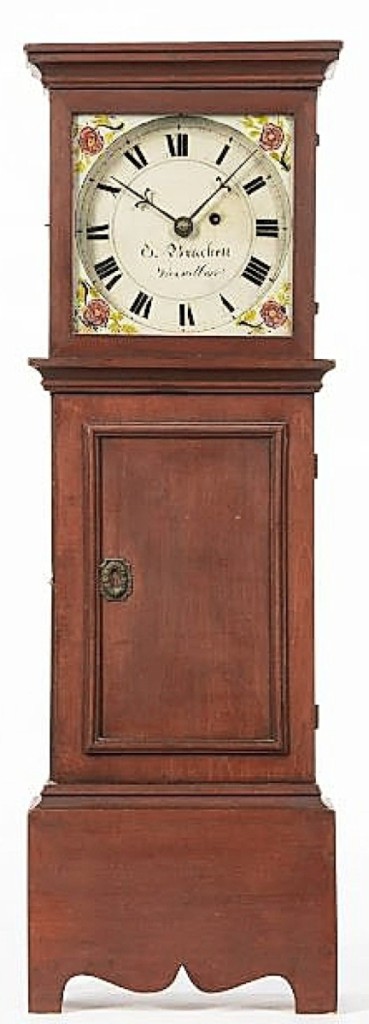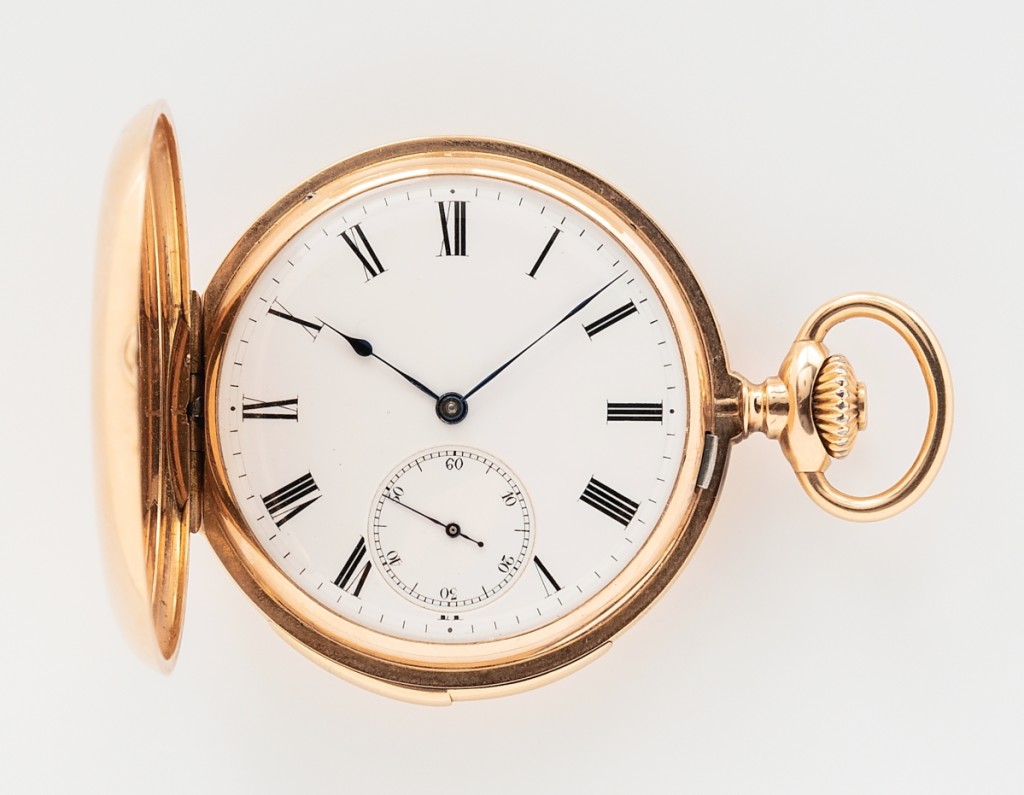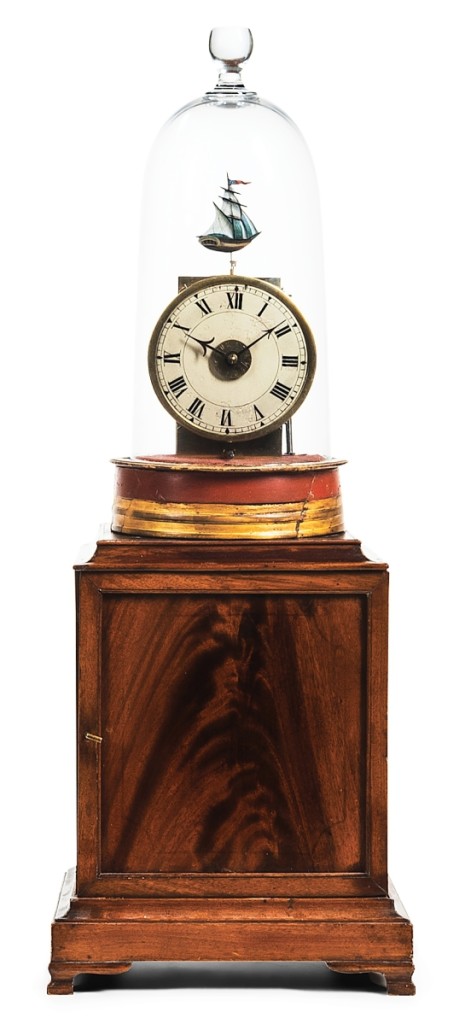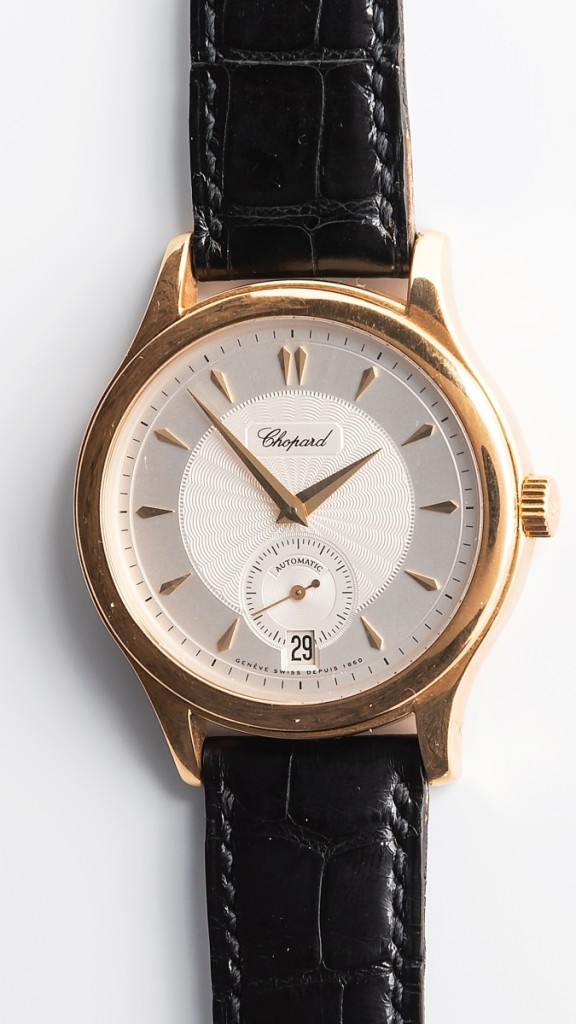
A red-stained maple Oliver Brackett dwarf clock, Vassalboro, Maine, circa 1840s, jumped its $10/15,000 estimate to land at $146,890. It featured a flat-top case with hinged upper door, reverse-painted floral-decorated tablet and painted Roman numeral iron dial with black surround. The sale’s catalog noted that a similar clock is shown in Furniture Treasury by Wallace Nutting, plate 3420, and this specific clock is pictured in a Eugene J. Sussel March 1950 ad in The Magazine Antiques.
Review by W.A. Demers, Photos Courtesy Skinner, Inc
MARLBOROUGH, MASS. – Skinner for 2022 has introduced a new format for sales in the clocks, watches and scientific instruments department headed up by Jonathan Dowling. The firm is offering four curated sales this year, with a variety of watches being offered in all four sales and clocks and instruments making periodic appearances. The first sale ran March 21-31 and offered classic sport and dress wristwatches as well as a variety of contemporary and vintage pieces. A red-stained maple Oliver Brackett dwarf clock, Vassalboro, Maine, circa 1840s, jumped its $10/15,000 estimate to land at $146,890. It featured a flat-top case with hinged upper door, reverse-painted floral-decorated tablet and painted Roman numeral iron dial with black surround. Marked “O. Brackett Vassalboro,” its waist door had applied molding and it rested on a high scroll-cut base. It was 29 inches high and was driven by a 30-hour weight-powered movement with iron plates, tin-cased weight and brass-faced pendulum. The sale’s catalog noted that a similar clock is shown in Furniture Treasury by Wallace Nutting, plate 3420, and this specific clock is pictured in a Eugene J. Sussel March 1950 ad in The Magazine Antiques.
Total for the sale was $674,956, with 91 percent sold by lot, according to Dowling, and it was able to be previewed on Skinner Live, BidSquare and LiveAuctioneers. The dwarf clock went to a private collector on the East Coast, the bidding at the end was between two private collectors.
The second highest selling lot in this sale was a Daniel Burnap cherry tall clock, East Windsor, Conn., circa 1790, which sold for $62,938, well above its $8/12,000 estimate. With a height of 93 inches, including finial, it featured a pierced fret with bold reeded columns above turned free-standing columns, an engraved silvered brass dial with floral decorated center. The arch engraved “Daniel Burnap E. Windsor,” it also had an oxbow-shaped full-length waist door, reeded quarter columns, stepped molded base on flared ogee feet, eight-day, time and hour strike movement and was regulated by two iron weights, with a wooden rod pendulum.

This 18K gold Patek Philippe hunter-case repeating watch came with great provenance, having descended in the family of John Torey Morse (1840-1937), historian and biographer who authored notable volumes on the presidents of the United States, including Alexander Hamilton. Its $4/6,000 estimate became history as it rose to $15,000.
“The market for good American clocks seems very strong,” observed Dowling. “The top two lots of my sale exceeded their estimates – collectors over the last several months seem to be abuzz that the market is getting renewed, and that trend is very exciting!”
Simon Willard clocks prove to be ever popular, with a Lighthouse alarm example, circa 1818, attributed to him taking $31,250 against a $7/9,000 estimate A painted iron rocking ship plies above the 5-inch diameter painted roman numeral dial with central alarm disc, winding arbor below, gilt and red-painted circular base, all mounted to a box-form mahogany base with hinged paneled door. On ogee bracket feet, it featured an eight-day brass movement with alarm train, and, with dome, stood 28½ inches high.
Luxury watches found favor. Fetching nearly three times its high estimate at $17,500 was a Chopard 18K gold L.U.C. 16/1860/2 wristwatch with box, circa 1990s. It had a stepped bezel, solid gold dial with outer minute track, applied faceted hour markers, dauphine hands, guilloche-decorated center, concentric turned sunk seconds and date at six. Catalog notes state that it wasn’t until 1996 that Chopard, with the help of independent watchmaker Michel Parmigiani, launched the high-end L.U.C. watch line using this reference, the 16/1860/2. The solid gold dials were produced by Metelem, the same Swiss dial manufacturer that produced Philippe Dufour’s Simplicity watches.

This Simon Willard Lighthouse alarm clock featuring a painted iron rocking ship, circa 1818, took $31,250 against a $7/9,000 estimate.
“Watches bring interest across all generations,” said Dowling. “It was a pleasure to handle and research some fine examples such as the Chopard, buoyed by the history of how it came to be. It wasn’t until 1996 that Chopard, with the help of independent watchmaker Michel Parmigiani, launched the high-end L.U.C. watch line using this reference, the 16/1860/2. The solid gold dials were produced by Metelem, the same Swiss dial manufacturer that produced Philippe Dufour’s Simplicity watches. Some have compared the quality of the 16/1860/2 to the Simplicity and to Patek Philippe’s caliber 240.”
Another good performance was posted by a John Torey Morse 18K gold Patek Philippe hunter-case repeating watch that left its $4/6,000 estimate in the dust and struck $15,000. The Roman numeral enameled dial with sunk seconds lay below blued steel hands, and its cuvette was engraved “A.H. Rodanet Constructeur de Chronometres/36 Rue Vivienne/Paris/No65730 Montre De Patek Philippe & Co. Geneve.” The watch had descended in the family of John Torey Morse, historian and biographer who authored notable volumes on the presidents of the United States, including Alexander Hamilton, one of his more significant works. Morse was born in 1840 in Boston and died in 1937 in Needham, Mass.; many of his papers, including correspondence and letters, are held by the Massachusetts Historical Society. Said Dowling, “Learning the provenance and working with the family that consigned the Morse Patek Philippe was also a great pleasure.”
An Edward Duffield (1730-1803) walnut tall clock, Philadelphia, circa 1770, earned $10,625. Duffield was one of the leading Philadelphia clockmakers of the Eighteenth Century. A colonial clock and compass maker, civic leader and educator, he was born and raised at “Benfield,” his family’s estate in what is now the Morrell Park neighborhood. His double-faced clock that hung outside his shop at 2nd and Arch Streets in Old City may have been the first public clock in America. He succeeded Peter Stretch as caretaker of the State House clock, and was known for his friendship with Benjamin Franklin, making clocks for Franklin’s family and serving as executor of his estate.

A highlight among luxury watches on offer was this Chopard 18K gold L.U.C. 16/1860/2 wristwatch with box, circa 1990s, that fetched nearly three times its high estimate at $17,500.
Rounding out top achievers in the sale, a Patek Philippe 18K white gold Reference 5109G-001 with box and papers that had been purchased in 2005 made $10,625. It had a silvered dial with applied Breguet numerals, blued hands, concentric turned subsidiary seconds, four-screw brushed back, signed leather strap and gold buckle.
“Overall, I am very pleased to have been able to put a sale together that is accessible for anyone in any market at any price point, and I am looking forward to the next sale,” Dowling concluded.
Prices given include the buyer’s premium as stated by the auction house.
The next sale is slated for June (no specific date yet), it has the possibility of being a “Live” sale that allows for online bidding, phone bids, and, of course, absentee bids. For information, 508-970-3000 or www.skinnerinc.com.











